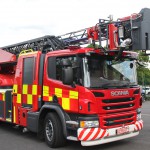A rise in electrical fires across South Yorkshire has been blamed on everything from phone chargers to e-cigs.
Fire officers say that whilst nearly every type of fire has reduced significantly during the last decade, thanks to safety visits and better awareness of risks, electrical incidents have stubbornly refused to drop.
Electricity is involved in about two thirds of all accidental house fires, with household appliances the most common culprits.
190 electrical fires
There were 190 house fires involving electricity in 2014/15, up from 165 the previous year and 150 in 2012/13. The kitchen is the most likely room in the house where electrical fires will start.
Sometimes fires are caused by faulty goods, which could be small items like mobile chargers, or big things like washing machines and dryers.
Fires are also caused by people misusing electrical appliances, for example by leaving them plugged in for too long or covering them up allowing them to overheat.
Fire officers are so worried about the problem, they have launched a safety video to try to educate people about the most common risks. The film has already been viewed more than 25,000 times on Facebook.
Head of community safety Kevin Ronan, said: “This isn’t about scaremongering but about making sure that consumers have all the available safety information. The vast majority of electrical goods are manufactured to very high safety standards, but sometimes if they are misused or if there is a fault with the device they can start a fire.
“The simple truth is that homes have more small electrical devices in them than probably any time in our history- from tablets and mobile phones, to e-cigarettes and games consoles. Unfortunately, we can’t get round everyone’s home to check the safety of their electrics for them. But by releasing this film, we hope we can give people the knowledge to check their own electrics and hopefully prevent a serious fire.”
The fire service has issued the following advice to stop fires:
- Don’t buy cheap, unbranded chargers and make sure chargers are compatible to the device you are using
- Don’t leave things to charge overnight or beyond the recommended charging time. Always follow the manufacturer’s instructions
- Keep electrical items away from flammable materials when charging
- Don’t overload sockets– long, strip adaptors are safest, but can only take a total of 13 amps
South Yorkshire Fire & Rescue is also calling on electrical manufacturers to do more to make people aware when faulty products are recalled.
Millions of recalled electrical products still in people’s homes
The number of fires caused by faulty large kitchen goods like fridges, washing machines and tumble dryers has increased from 42 fires in 2012, to 56 in 2013 and 60 in 2014.
A man died in a house fire in Gawber, Barnsley in 2012 in a blaze caused by a faulty fridge.
Manufacturers are required by law to notify people if they know one of their products poses a fire risk and needs to be recalled. But millions of faulty products remain in people’s homes.
“The average success rate of a recall is only 10-20%, which means that there are potentially millions of dangerous electrical products in homes across the UK.
“For consumers, we know that returning a recalled product is not always convenient, especially if it’s an item that you use every day, but recall notices are issued to keep people safe. The small inconvenience of returning a recalled item is worth it when you consider that faulty products can electrocute or cause a fire,” said Kevin.
For more information about this campaign visit our 13orbust online safety checker.

